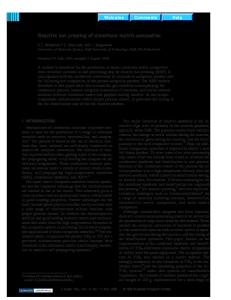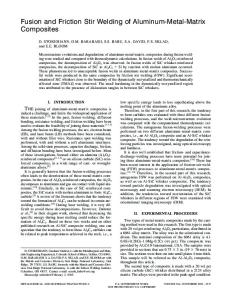Microstructurally toughened particulate-reinforced aluminum matrix composites
- PDF / 2,854,561 Bytes
- 12 Pages / 597.6 x 774 pts Page_size
- 97 Downloads / 363 Views
I.
INTRODUCTION
THE incorporation of silicon carbide particles or whiskers into conventional aluminum alloys has been shown to result in increased elastic modulus, strength, and elevated temperature capability relative to the baseline matrixy-8] However, the presence of the silicon carbide also acts to degrade fracture critical properties such as tensile ductility, fracture toughness, [8] and notched impact energy absorption capability. [8,9] This degradation of fracture critical properties has hindered the transition of the above composites into many structural applications because of reliability concerns. The current work is aimed at producing silicon carbide particulate-reinforced 6061 Al (SiCp/6061) composites with improved structural reliability. The basic measure used to assess structural reliability in the current study is the energy absorbed by the composite during notched Charpy impact testing. The approach investigated to increase the composite energy absorption capability involved creating a nonhomogeneous composite microstructure whereby continuous regions of the particulate-reinforced composite are separated by continuous ductile toughening regions. Composites produced with this segregated microstructure are referred to as microstructurally toughened (MT*) composites in the re*MT is a service mark of United Technologies Corporation, East Hartford, CT.
mainder of the paper. The tensile and notched Charpy impact behavior of a number of MT SiCp/606l base composites are presented and discussed below. VINCENT C, NARDONE, Senior Research Scientist, JAMES R. STRIFE, Principal Scientist, and K.M. PREWO, Manager of Materials Science, are with United Technologies Research Center, E. Hartford, CT O6IOB.
Manuscript submitted May 10. 1990. METALLURGICAL TRANSACTIONS A
II. MATERIALS AND EXPERIMENTAL PROCEDURE Two different types of MT silicon carbide particulatereinforced 6061 (SiCp/606l) base composites were fabricated for study. The first type consisted of discrete cylindrical regions of SiCp/606l contained within a continuous 6061 toughening region. The cylindrical SiCp/ 6061 reinforced regions had approximate diameters of 0.24, 0.16, and 0.12 cm. An overall cross-sectional view of the three composite microstructures is shown in Figure 1. The reinforced regions consisted of 25 pct SiC in the 0.24-cm size regions or 30 pct SiC in the 0.16and 0.12-cm size regions, with these reinforced regions occupying approximately 75 pct of the MT composite volume in all cases. Higher magnification views of the MT composites and the reinforced regions are shown in Figures 2 and 3. Note that the longitudinal section of the composite (Figure 3) shows that the reinforced and monolithic 6061 regions are continuous. Proprietary processing techniques were utilized to vary the interfacial strength between the reinforced and monolithic toughening regions in the composite microstructure. Composites fabricated with the rod-shaped SiCp/6061 reinforced regions and 6061 toughening regions will be referred to as Type I composites in the
Data Loading...











